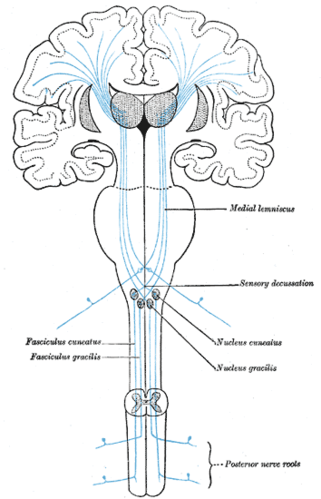Dorsal Column Medial Lemniscal Pathway
Original Editor - User Name
Top Contributors - Manisha Shrestha, Kim Jackson, Lucinda hampton, Vidya Acharya and Carina Therese Magtibay
Introduction[edit | edit source]
The dorsal column pathway is one of the ascending tracts i.e. the neural pathways by which sensory information from the peripheral nerves is transmitted to the cerebral cortex. In the spinal cord, this pathway travels in the dorsal column, and in the brainstem, it is transmitted through the medial lemniscus hence the name dorsal column-medial lemniscus pathway.
It deals with the conscious appreciation of fine touch, 2-point discrimination, conscious proprioception, and vibration sensations from the body except the head.
It is one of the major sensory pathways. Since it is a sensory pathway, there are three order neurons involved in this pathway that transmits signals from the skin and joints to the cerebral cortex.
Course[edit | edit source]
First order neuron[edit | edit source]
The cell body of the dorsal root ganglia, which is composed of pseudounipolar neurons, characterizes the first-order neuron of the pathway. The pseudounipolar neurons contain peripheral (distal) and central (proximal) axonal processes.
The peripheral (distal) axons receive various signal inputs from the skin via the receptors associated with the dorsal column medial lemniscus pathway. These receptors classify as two types: tactile mechanoreceptors and conscious proprioception.
Tactile mechanoreceptors include:
- Meissner's corpuscles, which are concerned with a fine touch and two-point discrimination
- Free nerve endings on hair follicles, which is concerned with a fine touch, and
- Pacinian corpuscles deal with pressure sense and vibration sense.
Conscious proprioception include:
- Muscle spindles and Golgi tendon organs which detect muscle length and contraction changes contributing to fine motor control and axial position.
The proximal axons of the dorsal root ganglia enter the spinal cord through the medial dorsal root entry zone. Once in the spinal cord, the central axonal process gives off small collateral branches that will terminate in the spinal gray matter to facilitate spinal reflexes. The majority of the central axonal process, however, will leave the dorsal horn gray matter without synapsing and enter the dorsal funiculus to help constitute either the fasciculus gracilis or the fasciculus cuneatus in ipsilateral side.
Fasiculus gracilis: It is located medial to the fasiculus cuneatus. It carries sensory information associated with the DCML pathway from the lower extremities. It then terminate and synapse with the nucleus gracilis in caudal medulla.
Fasiculus cuneatus: It lies lateral to fasiculus gracilis and carries sensory information associated with DCML pathways from the upper extremities. So, it is located at T6 and above. It then synapse with nucleus cuneatus in medulla.
Second order neuron[edit | edit source]
Both nucleus cuneatus and nucleus gracilis in medulla represent the second-order neuron of the DCML pathway. The axons of second order neuron from nucleus gracilis and nucleus cuneatus are known as internal arcuate fiber which cross at the level of medulla forming medial lemniscus and then travels through the brainstem with a preserved somatotopic arrangement. The medial lemniscus terminates and synapses in the thalamus particularly, in the ventral posterolateral (VPL) nucleus of the thalamus with the preservation of the somatotopy.
Third order neuron[edit | edit source]
Ventral posterolateral (VPL) neurons are third-order neurons of the pathway, and its axons will project laterally out of the thalamus and course somatotopically through the posterior limb of the internal capsule and then terminating in the primary somatosensory cortex of the postcentral gyrus.
Function[edit | edit source]
The primary function of the dorsal column pathway is to convey sensory information regarding fine touch, two-point discrimination, conscious proprioception, and vibration sensations from our skin and joints, excluding the head.
Blood supply[edit | edit source]
The posterior spinal artery supplies the posterior column pathway.
Clinical relevance[edit | edit source]
- Posterior cord syndrome, also known as posterior spinal artery syndrome- an infraction to posterior spinal artery.
- Tabes Dorsalis: It is a slow degenerative disease that represents a late manifestation of untreated syphilis. It can cause deleterious neurological deficits due to its involvement in the posterior column pathway. Symptoms include weakness, diminished reflexes, unsteady gait, progressive degeneration of the joints, loss of coordination, episodes of intense pain and disturbed sensation, personality changes, dementia, deafness, visual impairment, and impaired response to light.
- Subacute combined degeneration of the spinal cord (SCD): SCD is characterized by axonal myelin abnormalities in the mentioned pathways as a result of B12 deficiency, leading to a compromise in nerve transmission. SCD affects two pathways in the spinal cords: lateral cortical motor pathway and posterior column pathway.
- Brown-Sequard syndrome: It is a hemisection involving either the left or right side of the spinal cord, is a syndrome that usually happens at the cervical level and affects the posterior column pathway.
Assessment[edit | edit source]
Romberg test is part of a neurological exam used clinically to test for the integrity of the posterior column pathway.
Resources[edit | edit source]
- bulleted list
- x
or
- numbered list
- x







